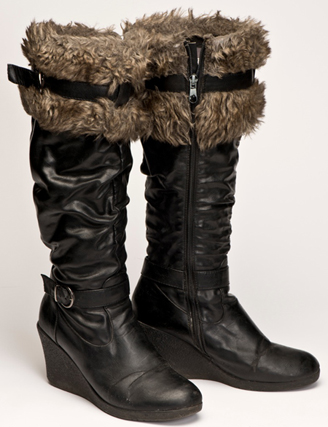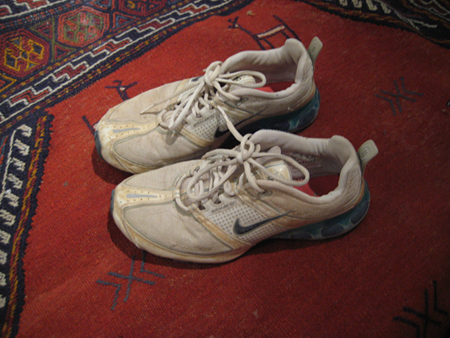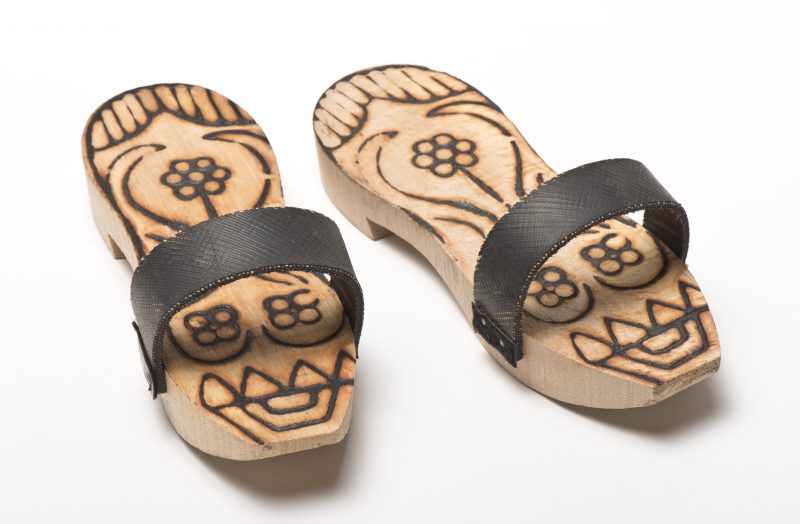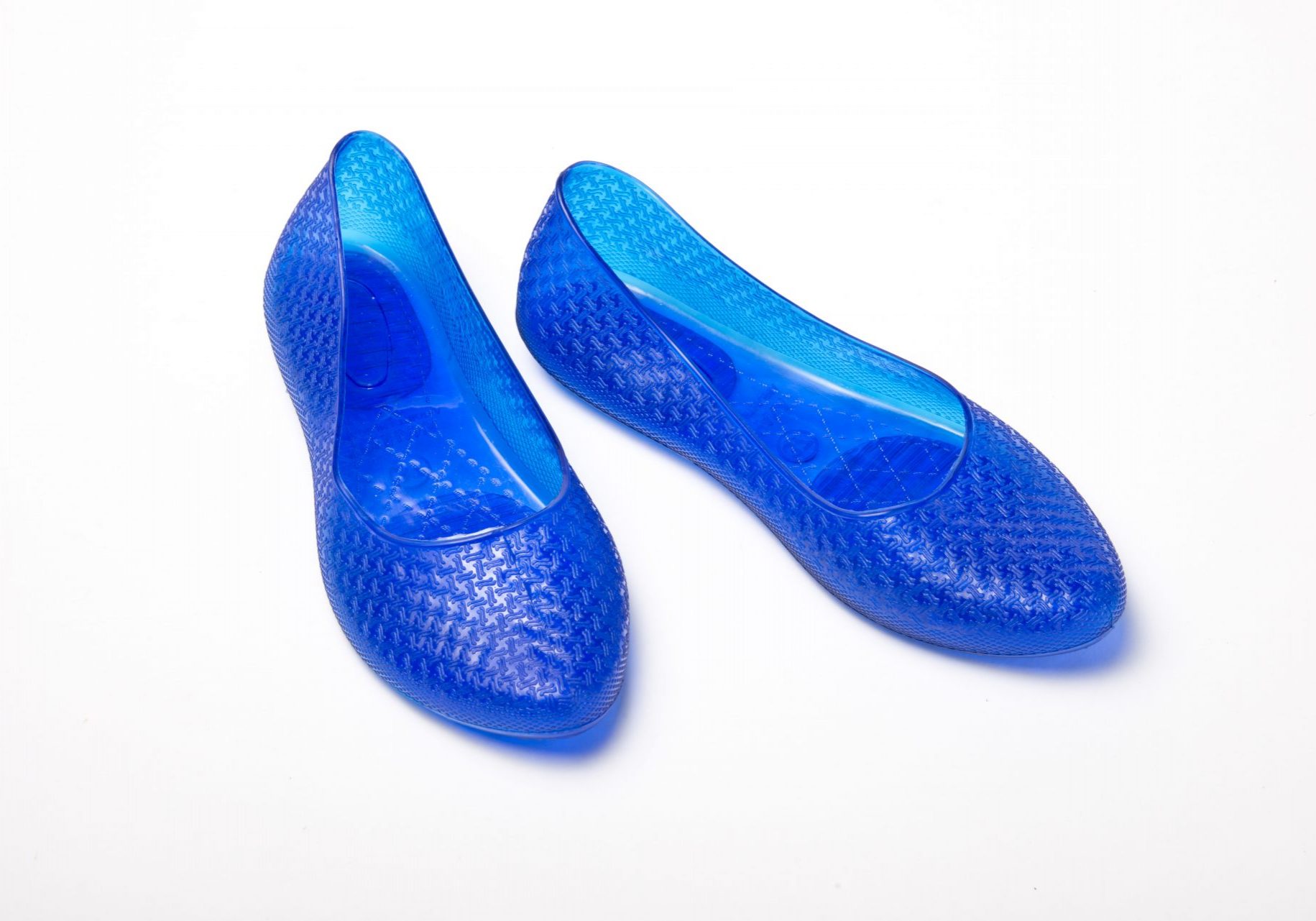Our
Stories
Since the first workshop in 2011, The Shoe Project participants have written over 300 stories and staged 30 performances.
Read about how their shoes brought them through their journey to Canada.
Watch our performances
Serap Tezgel
Turkey, Told by a Pair of Shoes
“The Shoe Project has created for me a fabulous platform to stand on and tell my story -- the immigrant story of which I can never have enough -- to the rest of Canada and by extension the world.”
- Teenaz Javat
Mojde Nikmanesh
Iran, Immodest Boots

Mojde Nikmanesh
Iran, Immodest Boots
Looking into my closet, I asked my husband, "How cold is it outside?" It’s snowing, he replied. My hand went toward my only boots but I remembered: "I’m going to a feminist meeting." Living as an Iranian refugee in Turkey, I had difficulty fitting into our new political group. I thought, “If I wear these stylish attractive wedge heel boots, nobody will take me seriously.”
I tried to remember the last time I wore them. It was after the Green Movement in 2008. I wanted to visit my friend in Hamedan. I bought my first pair of boots because it was cold there. On the way, the excitement of wearing these new boots kept me looking at them all the time. I especially liked the big fur trim at the top with the strap around it.
By the time I got there, it was getting dark and snowing. As soon as I got off the bus, my body started shivering. I waited for a taxi outside the terminal. The darkness and the strangeness of the new city made me shake even more. All of a sudden, I saw a van in front of me with the shadows of two men in the front seat and a woman in the back. As it got closer I saw the police sign. The older policeman told me to sit in the car. Having no option to run or resist, I did. The female police officer wore a black veil covering most of her face except her eyes. She looked at me viciously and said, “Those boots are very provocative. You are a Muslim girl. Where is your chastity?” I looked at the narrow shafts that revealed the shape of my legs. I wanted to scream, "No I’m not a Muslim! Who the hell are you to tell me who I am?" But I thought to myself, calm down. Take a deep breath. You are already in trouble for protesting at the university. The police might have your name in the system.
Humiliated and vulnerable, I gave her my purse. I watched her going through my pencil case, my notebook, reading the first two pages, and finally my wallet. She brought out my ID card and registered my name for the crime of wearing “immodest boots”. Then she gave me a big lecture about Islamic dress codes and Islamic mores. She ended her speech by saying “Stop dressing like a whore. Next time you will be arrested. Leave the street before committing more sin!”
My husband’s voice broke my train of thought. “Hurry, we’re going to be late for the meeting.” We had started a new life in Turkey. In this new group of activists, I felt judged by my appearance, behaviour and even my choice of words. This time it was not about whether I followed Muslim values; it was about patriarchal values. Again, I was limited in choosing my lifestyle.
I looked at my boots.
They were not provocative at all! Actually, they were an imitation of Russian Cossack boots only with a feminine ruffle on the front. They were the boots of a warrior.
And I thought, these boots are me, hiding in a closet for years. Living in Iran, I didn’t have a chance to be myself. And even after coming all the way to Turkey with the promise of freedom, my real me was still sitting in the closet.
My hand went firmly toward my boots. I said out loud: “It is time to stand up and make your own choice. It is me and only me who should decide what shoes I stand in.”
Mojde Nikmanesh is a 27-year-old women's rights activist from Iran who dreams about an equal, peaceful world for all human beings.
Rasha Elendari
Syria, Shoes for the Revolution

Rasha Elendari
Syria, Shoes for the Revolution
Today I am telling a story told to me by my older sister Manya who is now inside Syria running an organization to help internally displaced people escape the violence in their cities. Here it begins:
The middle class office workers in Damascus were a big part of the Syrian revolution: a fact Assad likes to keep hidden. When secretly planning their after-work demonstrations, these workers used a code! “Are you running today?” Manya asked when she called her friend Alice.
After work, Manya took off her work shoes, which are usually 3 or 4 inches high—she was just like most other Middle East women who loved their heels. Then she put on her running shoes. She met Alice who was still in her heels, which made Manya worry: “How could Alice run in these heels?” But she did not have time to tell her, as they were joining the march on a narrow street in the Old City. They were marching towards the famous square of Touma’s Gate, one of the seven remaining Roman gates surrounding the ancient city of Damascus.
Manya and Alice were among 150 youth peacefully protesting to demand an end to the bloodshed in other cities, and chanting: “We want a civil state and dignity….We want justice and freedom!”
They had not marched for more than a few steps before they were surprised by some Shabiha—what we call “Assad’s thugs”—who were everywhere undercover, lurking around, waiting. The Shabiha started attacking the protestors, using sticks and throwing whatever their hands could reach, even chairs and tables. They were overpowering, chanting “Long live Assad!” The protesters scattered in all directions. Some survived with no harm. Others were beaten and arrested.
Manya took off into a full-speed run. Images of dark cells and instruments of torture filled her head. She got lost, but she was thankful for the narrow tangled alleys the old city provides to freedom runners.
Her senses heightened, she could smell the scent of asmine everywhere. She could hear her heart throbbing and her running shoes clapping against the ancient basalt cobblestones.
Racing through those ancient streets and architecture, she thought about Damascus’s long history and the fascinating stories each brick could tell about the Assyrians, the Persians, the Greeks, the Romans, and the Umayyads.
“Are they still following me?” she wondered. “What if they catch me and arrest me? What would they do to me? To my family?” She had heard stories of women who got tortured and raped in Assad’s prisons.
“Will I make it to my wedding next week? Good thing I wore my running shoes today,” Manya thought. She had told Alice to wear hers too, but Alice said she didn't have any. She hoped Alice was still behind her.
Then Manya stumbled across another protester at the end of the alley. He told her they should buy a box of peaches and pretend to be a couple on their way home from grocery shopping. In this way, they managed to outsmart the thugs and arrived at Bab Touma’s Square where they separated without even introducing themselves.
As originally planned, she made it to her friend’s car where they were all supposed to meet. Minutes later, while waiting for Alice, Manya saw the Shabiha escorting a group of protesters to hand them over to the security forces. Amid this chaos, she spotted Alice—barefoot, carrying her shoes, walking in pride and courage despite the insults and abuse. Manya could do nothing but watch in sadness, and thought to herself, “I wish they’d caught me instead of Alice. At least, I don’t have kids. I should have given her my running shoes.”
It was July 20th, 2011.
Alice was detained and then released after two weeks of being tortured and beaten by Assad’s security forces. This didn’t stop her from protesting. She got arrested again and was jailed for a longer period. Alice lost her job, but when her life and the life of her kids were threatened, she managed to escape to Germany where she is now a leading activist. Manya told me that Alice is still dreaming of her “Wonderland” in Syria.
The road to freedom is a long one… and we should all have our running shoes for the journey.
Rasha Elendari is a Syrian doing a PhD in Near Eastern archaeology at the University of Toronto.
Maya Kabbani
Syria, Qib Qbs

Maya Kabbani
Syria, Qib Qbs
In the early morning, I was lazy and lay in bed. It was a chilly day in Toronto. But my room was filled with a lovely refreshing soap smell, a smell that took me back to a fall day in Damascus. I came back from school and opened the door to find my mom doing the seasonal cleaning. I could hear her voice: “Who’s that?”
“It’s me. Maya.”
“Take your shoes off outside. Be careful when you put your feet inside your slippers. Don’t put them on the floor. I just finished cleaning, and I don’t want to see any footprints!”
I did exactly what my mom said. While I was taking off my shoes, I noticed the vase behind the door was empty. She had taken the flowers to wash them.
I went through the guest’s washroom. The sink was sparkling. New towels matched the washroom colours of white and blue. The soap bottle was refilled. There were new bottles of perfume. She had put the washroom slippers on a new, white cloth to dry.
From the kitchen, I could see the balcony. The carpets were out in the sun. Mom believes sunlight is the best sanitizer ever. I could see the flowers dripping on the white, plastic table, making tiny lakes.
In the living room, everything was bright, neat, and smelling like love. Mom had taken the curtains to the laundry and removed all the frames and photos from the walls. She had washed the ceiling and walls—and even the TV.
Whenever I went with Mom to get cleaning stuff, I saw how much she cared. “This one cleans very nicely but doesn’t have a good smell,” she would say. “I’ll get this one for cleaning and also this other one that doesn’t clean so well but has a very nice smell.”
Mom is a practical person who wakes up early and starts organizing her tasks. I think if she had had a chance to go to school, she would have become a poet. She was a diligent student and very smart, but in grade ten, her father stopped her from going to school because Assad’s father banned the hijab in schools. That scared all the conservative people, so women lost! After that, she had two choices: to be a homemaker or a ‘gossip girl’. Mom chose the first, and in her free time, she read. Women like her competed to have the cleanest house, and my mom was the best.
She has very strict rules. Everyone wore four pairs of slippers in our house: one for the kitchen and hallway, another for bedrooms, one for the washroom and one for the balcony. Damascus is a city of people obsessed with cleaning, otherwise known as “OCD.” I was told many times, “Ohhh, you are from Damascus. Do you still have slippers for the washroom?” The answer is yes. These slippers are qib qbs. They are famous on TV shows, and there are even candies made to look like them.
Moving to my own place in Toronto was difficult. At first, I spent all the time cleaning like my mom, and I worked six days a week. But then my father passed away. When I got the news, I started wiping the floor. Then I stopped. “What are you doing, Maya? Are you crazy? Your father passed away yesterday! You have to give yourself time for grieving.”
After a while, I started to think about my life. Other women here have activities. But I just cleaned and worked. I decided to release myself from the strict rules and start some activities. One time I told Mom on the phone, “Yesterday I didn’t have time to wash dishes.” She replied, “I’d never forgive you if anyone saw your place not clean.” Then I said, “Mom, don’t worry. I have your spirit here in my place.”
Although my Toronto apartment is small, I use three pairs of slippers. After my daydream of our home in Damascus on that chilly morning, I got out of bed and put on my slippers. My washroom smelled clean and refreshing. I have recreated my mom’s home here in Toronto but on my own terms. When Canadian people take off their shoes at my front door, I am happy.
Maya Kabbani comes from Syria. She moved to Canada in 2017. For her, moving to Canada was a turning point in her life.
Sosina Ashenafi
Ethiopia, My Congo Shoes

Sosina Ashenafi
Congo, My Congo Shoes
One Saturday afternoon, I visited the Bata Shoe Museum in Toronto. I saw all kinds of shoes that mankind has been wearing since time immemorial. I ran from upstairs to downstairs as if I were looking for something I had lost, but the shoe that carries the pain and suffering of rural African women was not in sight.
In Ethiopia, that shoe is known as the Congo shoe. It is a very common rubber shoe used all over Sub-Saharan Africa. It is left out of the recorded history of human shoes—just as the story of the continent of Africa itself is left out of human history. Does that mean that my own story is not wanted either?
No matter what you think, I will tell you the story of my Congo shoe, the footwear of African women on the run.
Between 1960 and 1980, most African countries became free states, breaking from an old colony. Immediately after independence, they experienced civil war over resources and tribal lines. Who could be the next boss and control the country’s riches? When Congo had its post-colonial civil war, Ethiopian forces went there as part of the U.N. peacekeeping mission. When they came back home, they introduced the Congo shoe. It is rubber, cheap to buy and made for muddy roads.
In Ethiopia, my family is considered middle class, and my dad is an autocratic person who had control over everything in the household. He bought us whatever shoes he believed were suitable. Wearing Congos was out of the question. They were for the lower class, but I managed to get a pair of them from a friend.
They had a bad smell and made a farting sound when I jumped, but I liked them. They were comfortable for me to play in, and it was easy to run in them. My dad tried to punish me many times for wearing my friend’s Congos. Finally, he understood that he couldn’t stop me from wearing them. He bought me Congos of my own. My first pair was blue with a plastic bow.
Since my childhood in Addis Ababa, I have seen many women escaping their birthplace and family. I carry the image of them wearing their worn-out Congo shoes, travelling many moons to the city for a safe haven. But I did not see myself in those women.
Then my husband came to Canada as a political refugee. I was eager to follow him. But when the day came for our son and me to go, I wept to leave all my loved ones. After the airplane touched down on Canadian soil, the one hour I waited at Pearson airport to see my husband seemed like a century. When we were reunited, I started to cry again.
These days I am up and down. My thoughts often return to Ethiopia, where tribal conflict is displacing millions. I see those poor moms and their kids running from war, killings and hatred. I can feel the burning Congo on their feet as they wander the hot deserts.
They are running from an early marriage. They are running from an ethnic conflict or domestic violence. They are running from hunger and thirst. If a Congo shoe had a mouth, it would speak to the world about how those poor and miserable women walk their way from pain to pain.
Fighting with the weather, language and culture in a new country, I remember them. I may walk on snowy mud, but I wear comfortable rubber boots. Today, when I walk with my comfortable rubber boots, one of my legs always lags behind, as if it is going back, as if it is showing me that I, too, am a refugee.
SOSINA ASHENAFI, Ethiopian journalist and writer, came to Canada in 2018. She had published short stories, poems and essays in her native language Amharic. She is now editing and producing a monthly newspaper and weekly radio show titled New Perspective in Toronto.
Let’s share more stories. Together.
The Shoe Project was launched in Toronto in 2011. Since then, we have added chapters to Vancouver, Calgary, Halifax, Edmonton, Canmore, Windsor, Brampton, and Winnipeg, and are now a registered charity. We are committed to providing a truly national platform for the voices of immigrant and refugee women.